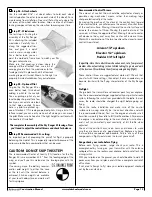
Page 12
www.oldschoolmodels.com
Construction Manual
Step 81 - Main gear installation
It’s time to install the main
landing gear. Place each of
the pre-bent 3/16” main gear
wires into the holes in the LG2s
on the bottom of the fuselage.
Place the two of the included
nylon landing gear straps in
position, then mark and drill
1/16” holes where the straps
should mount. Then the straps
using the supplied 2-56x3/4” self tapping screws.
Step 82 - Radio and Pushrod Installation
Although you can install the radio after covering your model, we
find it easier to get everything in place before covering. This way
you have unblocked access inside the fuselage and wings to get
the servos, extensions, and pushrods in place.
Shown here is a photo
of the radio gear’s
installation in the Sky
Ranger prototype.
Note that the throttle
servo was in a different
location than in the
production kits.
Make sure that when
installing the control
horns, they are placed
in-line with the pushrods, and that the line of holes where the
clevises attach are positioned over the hinge line.
For the average pilot, we recommend that clevises are attached to
the outermost hole on each control horn.
Finish the installation of your radio gear by adding the receiver,
flight pack battery and the switch. We mounted the receiver to
the fuselage side using a bit of self-adhesive hook-and-loop (not
included).
The flight pack battery is installed under the TF and the switch can
be installed on the side of the fuselage where desired.
Step 83 - Power system
Installing your power system of choice is up next. We’ll show photos
for electric and glow installations. Note that these are suggestions
only as your power system might vary from what’s shown here.
We mentioned this earlier, but it bears repeating. Our engine size
recommendation range is a .40-.45 two -stroke or an electric motor
with similar power output (800-900 watts, 80amp ESC, 4-5S).
Electric power
The motor mounts to the center of the
firewall and holes will need be drilled
to allow the wires to pass through into
the fuselage. Also a few cooling holes
are needed for internal battery cooling.
The ESC mounts underneath the TR1
battery tray and the motor’s power
battery mounts to the tray. Both the
ESC and battery are held in place with more self-adhesive hook-
and-loop.
Glow power
The engine mounts so the crankshaft
is positioned at the center of the
firewall. It can be mounted upright,
or side mounted as shown here on
the Sky Ranger prototype. Holes
will need be drilled for the throttle
pushrod and fuel lines to pass
through into the fuselage.
Step 84 - Covering
Now it is time to cover the Sky Ranger 40. Remove the powerplant,
main gear, tailwheel, pushrods, and any other components that
would get in the way of applying the covering.
Double check that all surfaces are smooth and ready to cover. Sand
as necessary, then cover the entire airframe with the covering/finish
of your choice.
Note that if you’re powering with an electric motor, you’ll need to
make a hole for the cooling air to escape the rear of the fuselage.
We choose to cut the covering away in this area, on the underside
of the fuselage.
When the covering is complete, re-attach all the components you
removed earlier in this step.
Logos, numbers, etc.
If you want to use graphics similar to the
ones we used, Old School Model Works
has teamed up with Callie Graphics as a
supplier for pre-cut vinyl. They are a very
well known provider of custom graphics
for R/C models.
We have supplied them with the artwork needed to cut the correct
size logos. You can order straight from them, choosing the colors
that work for you.
Contact Callie Graphics at this link: https://callie-graphics.com or scan
the QR code on the previous page.
Note that Callie Graphics is not affiliated with Old School Model
Works, nor does Old School Model Works generate any income
from this partnership.
Step 85 - Attach the Control Surfaces
Now is the time to attach all the control surfaces to the airframe, by
gluing the hinges in position with thin C/A.
Note that the tailwheel assembly should be in place, then the
rudder is attached. Only after those are installed, the elevator is
then attached.


































